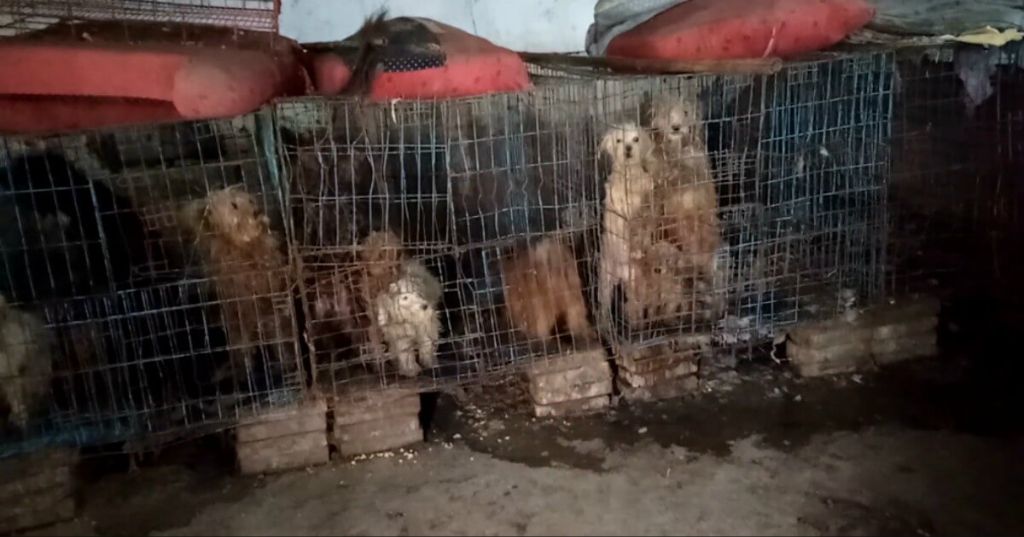Introduction
Dogs have a long and complex history in China. Archaeological evidence suggests dogs first came to China around 15,000 years ago. Dogs were valuable working animals for tasks like herding, hunting, pulling sleds and guarding homes. Certain dog breeds became associated with elite classes and the imperial palace. However, some Chinese also developed a taste for dog meat. Eating dog meat has ancient roots in China and other parts of Asia. Today, the practice remains controversial, with growing calls to ban the dog meat trade on animal cruelty grounds.
Though dog meat is consumed by a minority of Chinese, attitudes are mixed. Dogs are often still seen as livestock animals rather than pets. Yet dog keeping is on the rise, especially in cities. Animal welfare awareness is increasing, as is activism against the dog meat industry. The Chinese government has introduced new regulations on the trade and slaughter of dogs. Still, cultural differences over dogs persist between China and the West.
Dog Meat Trade
Dog meat has historically been consumed in certain regions of China, particularly in the south where it is considered part of the traditional cuisine. The most notorious dog meat eating festival is the Yulin Dog Meat Festival which takes place annually in Yulin, Guangxi province. According to a 2023 survey, almost 73% of surveyed Yulin region residents said they ate dog or cat meat at least once during the festival (source). However, the practice of eating dog meat remains localized and taboo in other parts of China. Estimates for total dog killings in China range from 10 to 20 million dogs annually for human consumption, though these figures are difficult to accurately verify (source).
The Yulin festival in particular has drawn intense criticism from animal welfare activists both within China and internationally. Although some defenders portray it as part of regional culture and identity, there are growing calls to end the festival on grounds of animal cruelty and risks to public health and safety.
Dog Breeding
China has a massive dog breeding industry to meet the growing demand for pets. However, there is often lack of regulation and oversight, leading to widespread unethical practices. According to a PETA Asia investigation, dogs are confined to filthy wire cages and suffer from painful health conditions caused by inbreeding in Chinese puppy mills Dogs Treated as Breeding Machines in Chinese Puppy Mills – PETA Asia Investigation. The dogs are treated solely as breeding machines to produce puppies for profit. A report by Sixth Tone notes that most pet owners in China have no idea where their dogs come from, allowing these cruel breeding practices to continue unchecked China’s Pet Industry Is Booming. So Are Its Horrific Breeding Practices.. There is an urgent need for stronger regulation and enforcement to improve the welfare of dogs in the massive breeding industry catering to China’s booming pet market.

Stray Dogs
China has a significant stray dog population, with estimates ranging from 10 to 20 million dogs according to the World Health Organization. Stray dogs pose challenges for public health and safety in major cities like Beijing and Shanghai. Packs of stray dogs are known to bite people, spread disease, and contribute to road accidents. According to a report by ChinaDialogue, Beijing sees around 1,300 dog bites per year, many from strays [1]. Shanghai has banned pet dogs from public areas of the city in response to stray dog attacks on residents.
The large stray dog population is attributed to factors like puppy mills, pet abandonment, lack of spaying/neutering, and inadequate animal control. Weak animal welfare laws also enable the problem to persist. While the government has taken some steps to address the issue, more action is needed to humanely reduce stray populations through sterilization, shelters, adoption programs, and public education. Overall, stray dogs remain an ongoing challenge across China’s major urban centers.
Animal Welfare Laws
China currently lacks comprehensive national animal welfare legislation. The only nationwide law related to animal welfare is the Wildlife Protection Law, enacted in 1988, which prohibits the hunting and killing of protected wild animal species but does not cover domestic animals like dogs.
In 2009, animal cruelty was added to China’s Food Safety Law as an offense, banning some acts like animal abuse at slaughterhouses. However, the law does not clearly define animal cruelty or provide penalties, making enforcement difficult. Some provinces and cities have enacted local regulations related to companion animal ownership, stray population control, and bans on dog and cat meat, but these are limited in scope and nature.
Overall, China’s animal welfare laws are still in early stages of development compared to many Western countries. Without comprehensive national legislation, there are gaps in protecting dogs from cruelty and abuse. Advocates continue to push for stronger laws, pointing to widespread problems like the dog meat trade, inhumane breeding practices, and high numbers of unvaccinated stray dogs. But cultural differences, human needs versus animal rights, and economic concerns provide resistance to greater reforms. Despite recent progress, China still has a long way to go in establishing animal welfare standards comparable to leading nations.
Changing Attitudes
In recent years, attitudes towards dogs have begun shifting in China, especially among younger generations in urban areas. Traditionally, dogs were viewed primarily as a food source or as pests. However, with rising incomes and increased exposure to Western culture, more Chinese are beginning to view dogs as companions rather than food.
Recent surveys have found that pet ownership is rising rapidly in China, with an estimated 73 million households owning pets as of 2018. Dogs are now the most popular pet in China. According to a 2021 survey by Statista, 39% of dog owners said their pet served a companion role, while only 2% saw dogs solely as a food source. The study found younger Chinese were more likely to see dogs as pets rather than utilitarian animals.
Activists have also launched public awareness campaigns to change perceptions of dogs and discourage the dog meat trade. Groups like No Dogs Left Behind have worked to rescue dogs from the meat trade and promote adoption. As activism rises along with more positive media exposure to dogs as pets, cultural attitudes appear to be gradually shifting, especially in urban areas.
Activism

In recent years, animal welfare groups have stepped up efforts to improve conditions for dogs in China. Organizations like the Humane Society International have campaigns dedicated to ending the dog meat trade and dog stealing in China. They work to educate the public, rescue dogs from meat trades, and lobby the government for legal protections (https://www.humanesociety.org/news/ending-brutal-chinese-dog-meat-trade-priority-humane-society-international).
Smaller rescue groups across China also work tirelessly to save dogs from meat trucks, provide them medical care, and find them adoptive homes locally or abroad. For example, groups like No Dogs Left Behind have rescued over 1500 dogs from the meat trade in just 4 years of operation (https://www.alibaba.com/showroom/rescue-dog.html). These groups rely heavily on volunteers and donations to fund their rescue efforts.
Activists also use social media to raise awareness, recruit volunteers, coordinate rescues, and pressure government officials. Popular figures like pianist Zheng Xiaoying leverage their platforms to speak out against cruelty towards dogs in China (https://www.thegatewaypundit.com/2021/03/president-trump-crashes-mar-lago-fundraiser-helping-dog-rescues-china-tells-crowd-lara-trump-will-run-senate/).
Government Initiatives
In recent years, the Chinese government has begun implementing new regulations and programs to improve dog welfare in the country. In 2020, the Ministry of Agriculture and Rural Affairs published a draft of the country’s first Animal Protection Law, which included provisions banning dog and cat meat consumption (https://en.wikipedia.org/wiki/Animal_welfare_and_rights_in_China). This represented a major step forward, as China previously had no laws specifically protecting companion animals like dogs and cats.

Some cities like Shenzhen and Zhuhai have banned dog meat consumption altogether. The Shenzhen government passed stricter regulations on the dog meat trade in 2020, officially outlawing dog and cat meat consumption. They also implemented a policy requiring labels on fur products so consumers can avoid buying dog and cat fur (https://api.worldanimalprotection.org/country/china).
In addition to legal bans, many government-funded animal shelters and adoption programs have emerged to reduce the stray dog population humanely. For example, Beijing has successfully sterilized over 75,000 roaming dogs instead of culling them, and runs adoption centers to rehome strays (https://faunalytics.org/reasons-to-be-optimistic-about-animal-welfare-in-china/). Though change has been gradual, these new regulations and programs signify a shifting mindset within the Chinese government regarding dog welfare.
Cultural Differences
There are significant cultural differences in how dogs are viewed and treated in China compared to Western countries like the United States. Historically, dogs have not been widely kept as pets or seen as family members in China. One major reason is economic – owning dogs as pets was seen as a luxury only affordable to the wealthy. The average Chinese family often lacked the resources to care for a dog as a pet rather than just for function.

Culturally, dogs have also not been as anthropomorphized and integrated into family structures in Chinese society relative to Western cultures. According to psychology professor Dr. Stanley Coren, “in China there is much more tendency to see dogs from a utilitarian perspective.” (Source) Dogs traditionally served roles like guarding, herding, hunting, etc. There was less focus on companionship or treating them like family members.
In contrast, in Western societies like the US, dogs are often considered part of the family with the same bonds of loyalty and affection attributed to human relationships. Having dogs as pets in the home is common across economic classes. Dogs are anthropomorphized, with birthdays, toys, clothes, and even “parents” dedicated to their care. This reflects fundamentally different cultural attitudes and norms around human-dog relationships in the West versus China.
Conclusion
In summary, the treatment of dogs in China is complex, with both progress towards improved welfare as well as ongoing challenges. While the dog meat trade persists and stray dog populations face threats, growing activism, government action, and changing societal attitudes point towards a more humane future for dogs. China’s expanding pet industry and ownership indicate dogs are increasingly seen as companions rather than just commercial goods or pests. However, differences in cultural views on animal welfare mean change may be gradual. Continued public education and pressure are needed to drive further reform. Though real concerns remain, there are promising signs that the overall welfare of dogs in China is improving.